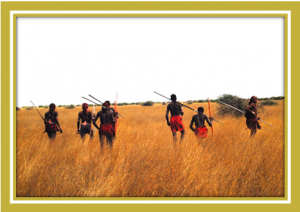News
Latest Lion Aid News
Meeting with a Maasai moran who killed a lion
Monday 9th December 2013

Don’t bother coming home if not successful This week we met with Daniel Ole Owaru (not his real name), who had hunted a lion in his youth. This was some time ago, when predator/livestock conflict was not much of an issue as there was plenty of wildlife for the lions to prey on. The occasional cow was taken, but these were usually animals that had become separated from the herds and lost in the bush. He said the training to become a moran (warrior) began early in life, but the real test of courage was the lion hunt. Prior to the hunt, the young men were taught by the Elders how to kill a lion before a group of about 5-10 aspirant morans set off on their test of courage. Some even failed at this first hurdle. Each of the young men was armed with a special rungu (a short wooden stick with a knob at one end, but for the lion hunt hardened to a very high degree), a short stabbing sword, a “medium” sized spear, and something I had never heard of before – a short stick the size of a pen sharpened at both ends. No shields were taken contrary to some early depictions in books. When the lion was found – it had to be a fully mature male (“if you kill a female lion you are cursed, and you might as well never go home again”), it was surrounded and provoked to charge. The short stick was held in the left hand (the arm wrapped in a cloth so the lion could not see it) and the spear in the right. This is the first time the young men would have encountered a lion at such close range, and as they had no practice in killing a lion, the moment must have been absolutely terrifying. The spear thrown at a charging lion had to be placed just alongside the neck. “If you spear a lion in the side it will not slow down and just become more angry”. If the lion came too close and tried to bite, the short stick came into play – it was thrust into the mouth and immediately jerked upwards to keep the jaws open. The first young man to place a spear in the lion could claim the honour of coming back with the mane. The others who participated also came home with honour, and then all lion hunt participants moved on to the next stage of their initiation ceremonies. If a lion was not killed, “don’t dare come home” was the message to Daniel. Overall, the number of lions killed in these ceremonies was low, perhaps one lion every 2-3 years in any area. The Maasai also believe that such hunts instill a sense of fear among lions to approach humans and their cattle too closely. They believe that when lion hunting was stopped, lions lost their fear and began causing the predator/livestock conflict apparent today. After many years Daniel’s mane from the lion he killed was taken away by the Government as he was no longer allowed to possess his “trophy”. Daniel also mentioned that many aspirant morans were killed by the lions in these hunts, and that many others today still bear the scars of their encounters. He said that lions are the most intelligent of all animals and not aggressive to humans – but they quickly sense when someone has bad intentions. It is interesting to note that many of these young morans who participated in lion hunts back in the day now stand at the forefront of the work to save the lion from the threats that engulf the species today. And how interesting to compare that lion hunt to the modern day trophy hunt. Now, hunters shoot lions off baits with high-powered rifles equipped with telescopic sights from a safe distance backed up by a professional hunter. Skill required? Next to nothing. Bravery? The Maasai would tell you not to bother coming home… Picture credit: http://artsandsciences.colorado.edu/magazine/2013/07/conservation-efforts-might-encourage-lion-hunting/ If you have not already signed up to our mailing list, you can add your name here and keep up to date with our ongoing work and, most importantly, DONATE to support our continuing work to conserve the remaining fragile lion populations and bring you the latest information. Thank you Please support our new project if you can Categories: Events/Fundraising, Traditional Medicine, Extinction, Domesticating Animals |
Posted by Chris Macsween at 11:48
No comments have been posted yet.
Add a new comment
Existing user
New user sign up



